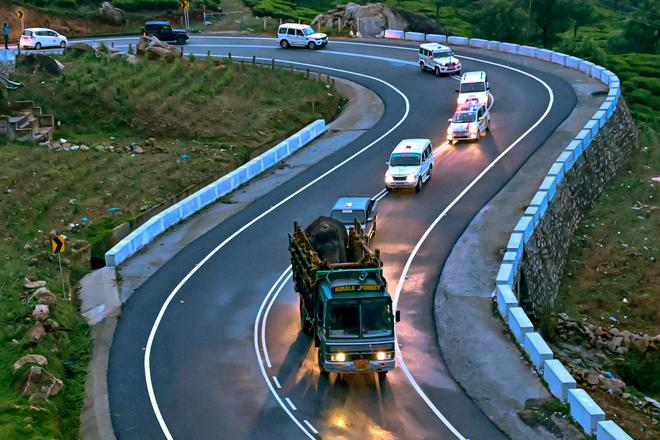Late on May 25, Arikompan made an attempt to return home. Forest officials tracked him to within 100 metres of a human habitation in Kumily, a village of spice and tea plantations, spread across a valley, in the Idukki district of Kerala. The lone tusker, now 36 years old, who was once part of a herd of 12, soon returned to the deep forests of Periyar Tiger Reserve in Thekkady, on the Kerala-Tamil Nadu border, 8 km away. For a change, the animal, partially blind in its right eye, caught after trampling seven people to death, injuring many more, and destroying at least 25 homes and shops, didn’t cause any damage to people or property. He did try to get some rice en route, but left without it.
Arikompan, derived from the Malayalam ari meaning rice and kompan meaning tusker, has developed both a personality and a reputation over the years, much like other elephants, Chakkakompan, a wild tusker who loves jackfruit in the same region, and Arisi Raja (rice king, in Tamil) of Pollachi in Tamil Nadu. Known to love rice, Arikompan often raided homes and shops in the Santhanpara and Chinnakanal panchayats, looking for food. In March and April, during the musth period, when bulls mate, he was found with two cow elephants and two babies.
With both villagers and the forest staff fearful of the elephant’s unpredictable raids over the last 10 years, the State forest department filed an affidavit detailing the damage Arikompan had caused. Based on this, the Kerala High Court, on April 13, ordered the translocation of the animal first to Parambikulam and then to Periyar Tiger Reserve, after consulting an expert committee.
Translocation for conservation
A crew of some 100 people including veterinarians, and government officials from every major department, including forest, fire, and electricity, gathered on April 29 to capture and transport Arikompan. The media was also invited. They stood by, with cameras, to shoot the event.
But the middle-aged giant, weighing no less than four tonnes, first needed to be tranquilised with five shots, and then coaxed via a ramp into a crate mounted on a truck by four Kumki elephants, trained animals involved in capturing and calming wild elephants. They tugged at a rope as thick as a forearm, and the partially sedated Arikompan walked into a truck.

A convoy made slow progress down the 100 km winding road from Chinnakanal, in the Idukki district, where the elephant had its last outing, to Kumily, in Thekkady, the gateway to the Periyar Wildlife Sanctuary. The police, wary of a backlash from irate villagers who had all faced trouble from the elephant, had put restrictions to people venturing out, and even imposed a curfew under Section 144 in Kumily.
The grim, tense staff were in for a surprise. People defied the restrictions imposed by the police. They lined the road on both sides, and tossed petals and shouted hoorays at Arikompan.
“The public’s response was unprecedented,” said one of the veterinarians who was part of the convoy. “We were expecting stones instead of petals as the elephant, which breathed ferocity, had already generated so much public anger and even protests in some parts of the State.”
At Kumily, the tusker was accorded a formal reception by the locals with a special puja. The journey was bumpy and slow as the convoy had to negotiate an unpaved road onto which wildlife often strays. The tusker was slowly released into the wild at Senioroda, about 22 km from Kumily, in the interior reaches of the tiger reserve.
With this translocation, the forest department claims that the incidence of human-elephant conflict in the Chinnakanal region has come down sharply. P.V. Vegi, Range Forest Officer, Devikulam, says this is evident from the dwindling number of complaints on straying elephants. The local administrators too attest to an abrupt stoppage of human-elephant conflicts with the tusker’s absence. “Over 80% of the issues have been solved with the translocation of Arikompan. This is a clear vindication of the stance taken by the two panchayats that moving him out of the region would alone solve the issue,” said Sini Baby, president, Chinnakanal Panchayat.
Human-wildlife conflict
An area where Arikompan had previously wreaked havoc on most occasions was the 301 colony. This land had been assigned in 2003 by the Kerala government, near the Anayirangal dam that is built on the Panniyar River in Chinnakanal and Shanthampara panchayats. The hamlet, which conservationists argue is located in the middle of an elephant corridor that extends from the Chinnar Wildlife Sanctuary in Idukki to the Periyar Tiger Reserve, is currently inhabited by 41 people belonging to 15 tribal families. The rest have moved out over the years, fearing for their life and livelihood that is derived from forest produce, in view of the recurring wildlife attacks.
The settlement here, unfortunately, came into existence against the will of the forest department that had called for establishing an elephant sanctuary instead. That way, it would have served as a contiguous tusker habitat along with the Anamudi Elephant Reserve from Parambikulam to Mathikettan Shola, on the Kerala-Tamil Nadu border.
The hapless residents of the 301 colony, however, were completely unaware of such technicalities while settling there. For them, the loud screaming and trumpeting of wild elements were part of the region’s soundscape.

The shortage of food, according to locals, was the key factor in forcing animals to stray into the human settlements of Chinnakanal. “The 365-hectare wide revenue land, where the elephant herd including Arikompan is located, is crowded with eucalyptus trees. If the authorities could convert it to a grassland, it would serve as an ideal habitat for wild elephants. The forest department, sadly, is not initiating a single step to ensure proper food for the wild elephants in the region,” pointed out P.N. Jaimon, a farmer settled in Sinkukandam, Idukki district, reflecting on the fact that translocating one elephant may not be the answer.
The focus has now shifted to the Kerala-Tamil Nadu border where Arikompan was released. Outfitted with a satellite radio collar, the animal has moved back and forth between Kerala and Tamil Nadu and traversed around 40 km so far.
Also read | Arikompan mission puts kumki elephants in the limelight
After vanishing into the deep forests for a couple of days, the tusker first emerged at Vannathiparai under the Srivilliputhur-Megamalai Tiger Reserve in Theni district, Tamil Nadu, which is a contiguous forest of the Periyar Tiger Reserve. It then returned to the Mangaladevi-Mavadi area inside Kerala and moved to the foothills of the theSrivilliputhur-Megamalai Tiger Reserve through the Eravangalar Highways Dam. From there, it went further uphill to reach Manalar and spent several days in the various estates and Shola grasslands, before returning to the Kerala border on May 22. It camped in the Periyar Tiger Reserve for the next five days before entering Rosapookkandam, a habited area adjoining the reserve, on May 25 night. Driven away by forest officials, the tusker returned to the Tamil Nadu forests the next day.
Though Arikompan accidentally blocked a bus to Megamalai from Chinnamanur, in Tamil Nadu, nothing untoward has happened so far. The forest department in Tamil Nadu has sought to allay any concerns. “The elephant is not showing any aggression as it looks happy loitering around after foraging in this new landscape. We are closely monitoring its movement in association with the Kerala Forest Department,” said Srinivas R. Reddy, the chief wildlife warden, Tamil Nadu.
The department, according to him, is yet to ascertain whether the animal was exploring options to settle down in its new home or attempting to find its way back to its original home. “The present trajectory of the tusker suggests it is just moving to all the areas where it is likely to get food and water,” added Mr. Reddy.
Arikompan and the future
Experts reckon that it takes time to be certain that translocation has worked.“The elephant looked nearly settled in the region until a few days ago, but going by its behaviour, a return to its original habitat cannot be ruled out. The Periyar Tiger Reserve and the adjacent forest area will provide enough food and water to the animal,” said P.S. Essa, a wildlife expert and member of the expert committee appointed by the Kerala High Court, explaining the choice of location.
Chief veterinary surgeon Arun Zachariah, who headed the translocation operation of Arikompan, noted that the tusker will be absorbed into its new habitat about three months after translocation. “The tusker was translocated to a new area as a special case after much analysis and discussion. With the animal now gradually adapting to its new home, the operation sets the benchmark and can serve as a textbook for such cases in future,” he said.
Also read | 301 colony, A sitting duck for Arikompan
The tusker’s introduction to the Periyar Tiger Reserve is also expected to facilitate a transfer of new genes in the region. “As the elephant keeps moving on both sides of the forest in Kerala and Tamil Nadu, it will help transfer new genes. We hope the process will ultimately help bring up a healthy and functional elephant population in both the Periyar Tiger Reserve and the Megamalai Tiger Reserve,” said Arun R.S., chief conservator of forests, High Range Circle, Kerala.
Another group of people though feel the animal should have been kept in captivity. “The interference of the Kerala High Court in the matter has caused huge expenditure for the exchequer and huge anxiety to the people of two States,” Alex Ozhukayil, chairman of the Kerala Independent Farmers Association, held.
Animal rights activists, meanwhile, have advocated a wait-and-watch approach before they conclude that the re-homing operation has been successful. A translocated elephant, they say, generally exhibits three types of behaviour after being moved to a new terrain.
“They may adapt to the conditions of the new habitat and continue there. In the second case, the animal wanders across the translocated place, while in the third case, it will try its best to return home, no matter how far the location is,” said M.N. Jayachandran, district secretary of the Society for the Prevention of Cruelty to Animals.
Also read | Mission to capture Arikompan likely to cost ₹10 lakh
Everyone is waiting to see what Arikompan will do. Will he stay or will he go back? Only time will tell. What everyone agrees on is that this is an experiment in conservation through translocation.
The forest department is not initiating a single step to ensure proper food for the wild elephants in the region.







